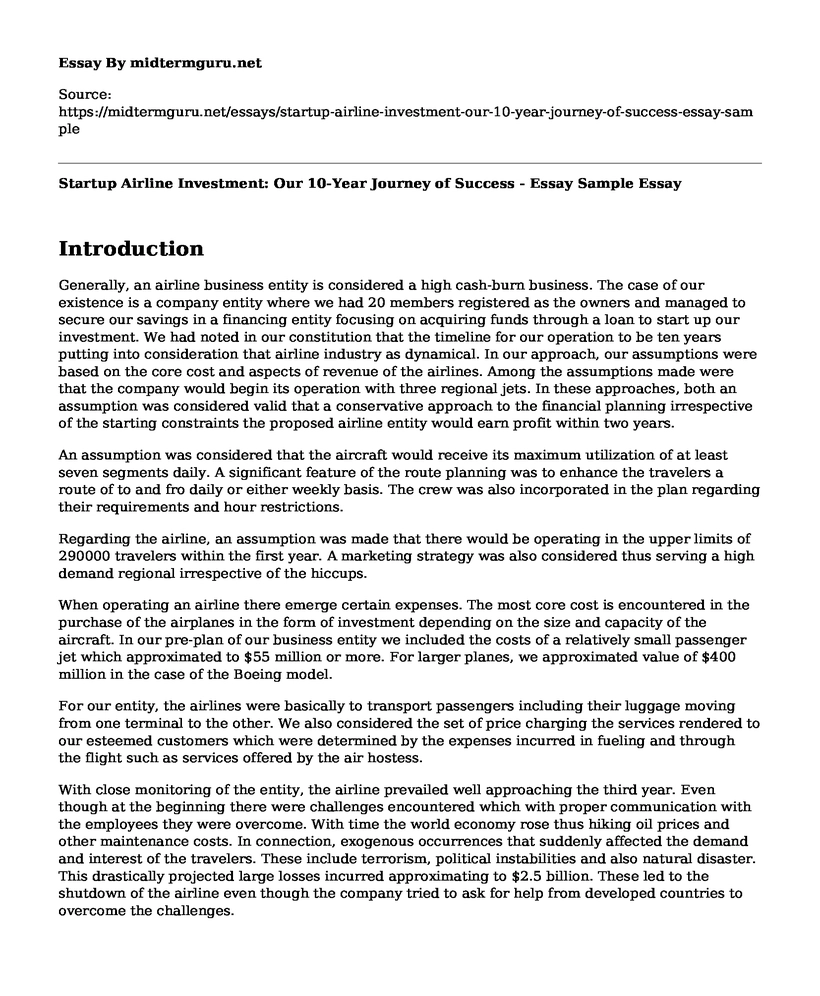Introduction
Generally, an airline business entity is considered a high cash-burn business. The case of our existence is a company entity where we had 20 members registered as the owners and managed to secure our savings in a financing entity focusing on acquiring funds through a loan to start up our investment. We had noted in our constitution that the timeline for our operation to be ten years putting into consideration that airline industry as dynamical. In our approach, our assumptions were based on the core cost and aspects of revenue of the airlines. Among the assumptions made were that the company would begin its operation with three regional jets. In these approaches, both an assumption was considered valid that a conservative approach to the financial planning irrespective of the starting constraints the proposed airline entity would earn profit within two years.
An assumption was considered that the aircraft would receive its maximum utilization of at least seven segments daily. A significant feature of the route planning was to enhance the travelers a route of to and fro daily or either weekly basis. The crew was also incorporated in the plan regarding their requirements and hour restrictions.
Regarding the airline, an assumption was made that there would be operating in the upper limits of 290000 travelers within the first year. A marketing strategy was also considered thus serving a high demand regional irrespective of the hiccups.
When operating an airline there emerge certain expenses. The most core cost is encountered in the purchase of the airplanes in the form of investment depending on the size and capacity of the aircraft. In our pre-plan of our business entity we included the costs of a relatively small passenger jet which approximated to $55 million or more. For larger planes, we approximated value of $400 million in the case of the Boeing model.
For our entity, the airlines were basically to transport passengers including their luggage moving from one terminal to the other. We also considered the set of price charging the services rendered to our esteemed customers which were determined by the expenses incurred in fueling and through the flight such as services offered by the air hostess.
With close monitoring of the entity, the airline prevailed well approaching the third year. Even though at the beginning there were challenges encountered which with proper communication with the employees they were overcome. With time the world economy rose thus hiking oil prices and other maintenance costs. In connection, exogenous occurrences that suddenly affected the demand and interest of the travelers. These include terrorism, political instabilities and also natural disaster. This drastically projected large losses incurred approximating to $2.5 billion. These led to the shutdown of the airline even though the company tried to ask for help from developed countries to overcome the challenges.
Operational challenges also arose which caused the entity collapsing. Finally, the body was resolved. Each member had to get a share as per contribution after liquidifying the existence. In conclusion, an Income statement is a significant element in the financial summary for it projects the ability of a company to generate profits while a balance sheet is used to indicate what a company owns and what it owes external entities at a specific duration of time.
The airline industry is a large sector of investment associated with drastic changes in how individuals live and interact through the world. Traveling by flight has become a household concept since various aspects of human has been directly affected most likely on how individuals conduct businesses, social interactions among other reasons why people so fast from one locality to another.
Works Cited
Busse, Meghan. "Firm financial condition and airline price wars." RAND Journal of Economics (2002): 298-318.
Riley Jr, Richard A., Timothy A. Pearson, and Greg Trompeter. "The value relevance of non-financial performance variables and accounting information: the case of the airline industry." Journal of accounting and public policy 22.3 (2003): 231-254.
Cite this page
Startup Airline Investment: Our 10-Year Journey of Success - Essay Sample . (2023, Jan 06). Retrieved from https://midtermguru.com/essays/startup-airline-investment-our-10-year-journey-of-success-essay-sample
If you are the original author of this essay and no longer wish to have it published on the midtermguru.com website, please click below to request its removal:
- Critical Analysis of the Static Budget - Report Paper Example
- Background and Rise of the Eastman Kodak Company - Paper Example
- Evaluation Essay on eBay Incorporation
- Essay Sample on Importance of Intracompany Guides to Employees
- Tax Compliance & ACA: Essential Knowledge for Business Owners - Essay Sample
- Theory of Constraints (TOC) - Essay Sample
- Improve Performance With DMAIC: A Six Sigma Process - Essay Sample







